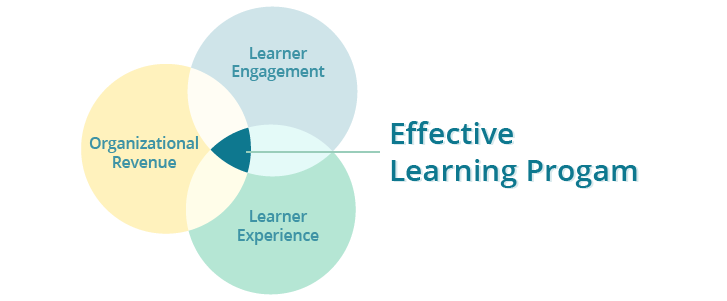3 Pillars for an Effective Learning Program (Part 4): Putting It All Together
Today’s organizations face a balancing act with learning programs: meet the rising expectations of modern professionals, while also developing financially sustainable programs. Do yours make the grade?
To create programs that are good for learners and good for business, many organizations need a fresh approach to their learning strategy. Over the past few weeks, we’ve shared the three pillars of an effective learning program:
- Learner engagement. When learners are truly invested, they’re more likely to stick with their coursework and come back for more education throughout their careers – a win-win for them and the organization.
- Learner experience. A great learning experience is key for keeping learners engaged, supporting ongoing customer relationships, and expanding program reach to new professionals.
- Organizational revenue. Often the overlooked ingredient in a learning strategy, profitability is critical for programs to thrive over the long run.

For training companies, credentialing bodies, and industry associations, the need to develop an effective learning strategy has never been greater. Two in three working adults have participated in professional learning in the past year, and the trend toward lifelong learning for professionals is here to stay. Organizations that create engaging, differentiated programs will have a huge industry advantage in the years to come. But how do you tie all these learning pillars into a unified strategy?
Through personalized, digital learning.
Your checklist for a successful learning program
While digital, one-size-fits-one approaches are gaining recognition across the industry, many organizations are still relying on outdated solutions that leave learners wanting more. In-person courses and paper-based materials aren’t learner-friendly for busy professionals, and traditional learning management system platforms prioritize content management over creating a premium learning experience. These options also offer limited functionality and ability to scale, preventing businesses from expanding their reach into new markets and users.
By incorporating best practices into learning programs, organizations can achieve the triple aim of learning – learner engagement, learner experience and organizational revenue – and drive greater success for professionals and their bottom lines. To see how your own program stacks up, here are five questions to consider.
- Is it available on any device? Tethering modern workers to a classroom or even a laptop is sure to cause frustration and dropoff. That’s why nearly half of learning organizations are already using mobile learning. Look for digital solutions that sync seamlessly across mobile, tablet, and web, making it as easy to brush up on flashcards during the commute home as it is to play a game on your cell phone. Bite-sized lessons can also help learners fit studying into their day and hold their interest more effectively.
- Can I configure it for a variety of exams or products? Launching a new teaching course can be a huge operational lift for organizations that offer in-person classes or use a standard learning management system. A solution with advanced configuration capabilities makes it easier to add courses without starting from scratch each time. That means organizations can offer a variety of formats (like blended live and online programs), boost revenue by expanding into new subject areas, and reach learners in areas where in-person learning isn’t an option.
- Can I personalize the learning experience for each professional? Different learners have different needs – so why do many programs treat everyone the same way? By tailoring programs to individual strengths and weaknesses, organizations can help learners make the most of their time and increase success on exam day and beyond. BenchPrep research shows that following a learning pathway improves user engagement by almost 100%.
- Am I engaging my learners each step of the way? The learner journey is often long, with some certifications taking a year or more of preparation. How can you ensure you’re not losing learners along the way? Features like games, social learning functionality to collaborate with other users, and real-time insight into progress can help learners keep their eye on their end goals.
- Am I getting the data I need to optimize my programs? While user-level insights can help learners understand what they’ve mastered and where to focus their time, the real value comes from organizational-level data. By accessing real-time data on which questions users are skipping, which programs have the highest completion rates, and other need-to-know details, organizations can better understand learner behavior and content efficacy. These types of actionable insights are key for optimizing programs.
As the only platform built around the needs of modern learners and organizations, BenchPrep delivers a premium learning experience to millions of professionals while delivering bottom-line benefits to businesses. See how BenchPrep can help you build a learning strategy that incorporates these three pillars, helping your business and your learners achieve your goals.






